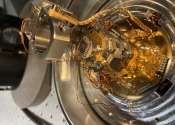Eavesdropping on the electron: A new method for extracting data from noise
A method developed at the University of Duisburg-Essen makes it possible to read data from noisy signals. Theoretical physicists and their experimental colleagues have published their findings in the current issue of Physical ...









